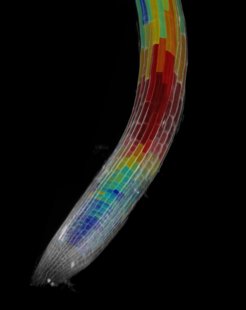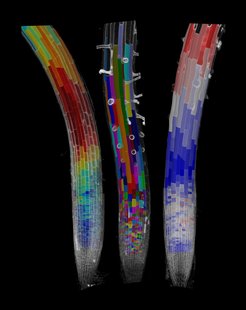Roots stiffen up to stop growth
The plant hormone cytokinin inhibits root cell growth
With the onset of spring, comes the first flush of green as leaves begin to emerge. Hidden from view are the roots of plants, which grow and spread beneath the soil to extract the nutrients and water needed for growth. How plants control root growth is an important question in biology that is being investigated in a small mustard plant, called Arabidopsis thaliana. In a new study, scientists from the Max Planck Institute for Plant Breeding Research in Cologne, have determined how newly formed cells in Arabidopsis roots stop growing. It seems they do so by becoming stiffer.

These discoveries are important because, as lead scientist Director Miltos Tsiantis explains, ‘It may be possible to tinker with root growth to improve crops in different environments. For example, breeding plants where the cell wall stays softer for longer may lead to longer roots that can access deeper layers of soil for water, which could be important under conditions of global warming.’
The Arabidopsis root has a simple structure organised into zones, making it ideal to study. Near the root tip, stem cells divide to form new cells. These new cells divide and form a region called the elongation zone, where they stop dividing and grow by elongation. They then mature in a final zone. Previous studies have uncovered the plant hormones and genes that regulate this process. But exactly how new root cells know to stop growing remains unknown.
In their new study, PhD student Shanda Liu, Miltos Tsiantis and co-workers including computer scientist Richard Smith now at the John Innes Centre in Norwich, UK as well as scientists from Rome and the neighbouring HHU University in Düsseldorf investigate this question. Liu explains, ‘We know a lot about the genes that control root development. However, we know less about how different root tip cells grow to give the final root form and about how roots stop growing.’ Smith said “it is exciting to see computational approaches our group developed for studying morphogenesis to now be used to study the cessation of growth”
Cytokinin stops roots from growing
In their study, Liu, Tsiantis and colleagues discover that a plant hormone, called cytokinin, plays a key role in stopping root cells from growing. The scientists also discover that when root cells stop growing, their cell walls become increasingly stiff. Tsiantis explains, ‘Our study shows that cytokinin underlies the ‘stop’ of root growth. And that this stop involves cell wall stiffening. This in turn indicates that making plant cells stiffer may be an important mechanism through which genes and hormones ultimately act to stop plant growth.’
The scientists made their discoveries by capturing microscopy images of growing and maturing root cells in living Arabidopsis roots and exploiting microfluidics devices developed by Guido Grossmann from the HHU, a co-author of the study. These images show where and when root cells grow, stop growing and mature. The scientists also noticed that in plants with lower levels of cytokinin signalling it took longer for root cells to stop growing. Another set of experiments combined with computational modelling showed that cells in the elongation zone – which are ceasing to grow - have stiffer cell walls.
Changing properties of the cell wall

The growth of plants depends on the properties of their cell walls. This is because plant cells cannot move to create new forms and tissues because their cell walls cement them in place. Instead, plants create new forms and shapes by changing their growth which involves altering the mechanical properties of their cell walls. The findings provide a wealth of new information about how and where root cells grow and stop growing, and about how they alter their cell behaviour as they mature and are regulated by hormones, such as cytokinin. The microscopy and computational approaches they use in this study might also be useful to other plant scientists.
As Tsiantis explains, ‘The microscopy approaches we use here could also be used to investigate how other genes or hormones affect cell growth along the root, to regulate its development. And to determine whether they also affect cell wall stiffness. Cytokinin also acts in above-ground parts of a plant, such as the leaves. So, it would be interesting to know if it regulates the growth of leaves in a similar manner as it does in roots.’













